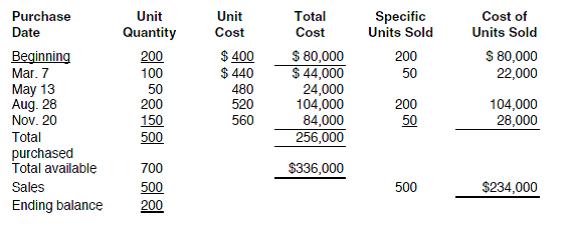Question
Del Rio began Rio Enterprises on January 1 with 200 units of inventory. During the year, 500 additional units were purchased, 500 units were sold,
Del Rio began Rio Enterprises on January 1 with 200 units of inventory. During the year, 500 additional units were purchased, 500 units were sold, and Del ended the year with 200 units. Del is very satisfied with his first year of business although the cost of replacing his inventory rose continually throughout the year. The 500 units sold for a total of $320,000 and the 500 units purchased to replace them cost $256,000, so his cash account has increased by $64,000. Del is concerned however because he has three obligations yet to meet: taxes, dividends, and his wife. Federal and state income taxes will take 40% of his income. His investors are to receive dividends equal to half of any income after taxes are paid. And finally, Del promised his wife a big trip to Hawaii if she let him quit his job as a professor and start his own business. He promised her he'd “make at least $50,000 after taxes. That will give us $25,000 after paying off the investors.”
Del kept fairly good records during the year and knows the specific cost of each inventory unit sold. He has prepared the following table to summarize his purchases and sales.

A quick calculation shows that Rio's net income will be $51,600 using specific costs for the inventory sold. Sales minus cost of goods sold equals gross profit ($320,000 – $234,000 =
$86,000). Taxes to be paid are 40% ($86,000 ◊◊.4 = $34,400). Subtract taxes from gross profit to get net income ($86,000 – $34,400 = $51,600).
Next, Del calculates his ending cash balance. He currently has $64,000 from his sales less his inventory replacement purchases ($320,000 – $256,000 = $64,000). He needs to pay taxes ($34,400) and dividends to his investors ($51,600 ◊◊.5 = $25,800). Subtracting $34,400 and $25,800 from $64,000 leaves him with only $3,800. Yikes!
Del is shocked by the computations. He cannot figure out how he will ever explain to his wife that he has net income in excess of $50,000 and yet after paying off the investors he will have only $3,800 to show for it! Del knows you are taking an accounting class and comes to you for help.
REQUIREMENT
Using a pencil, fill in columns F and G in the Data Section of the worksheet printout at the end of this problem.
Purchase Unit Cost of Unit Cost Total Specific Units Sold Date Quantity Cost Units Sold $ 80,000 $ 44,000 24,000 104,000 84,000 256,000 $ 80,000 22,000 $ 400 $ 440 480 520 560 200 Beginning Mar. 7 200 100 50 200 150 500 50 May 13 Aug. 28 Nov. 20 104,000 28,000 200 50 Total purchased Total available 700 $336,000 500 200 Sales 500 $234,000 Ending balance
Step by Step Solution
3.42 Rating (152 Votes )
There are 3 Steps involved in it
Step: 1
Step 1 of 2 In the open worksheet file record the inventory sold using FIFO and ...
Get Instant Access to Expert-Tailored Solutions
See step-by-step solutions with expert insights and AI powered tools for academic success
Step: 2

Step: 3

Ace Your Homework with AI
Get the answers you need in no time with our AI-driven, step-by-step assistance
Get Started


